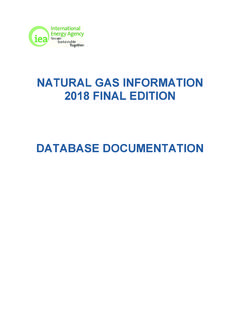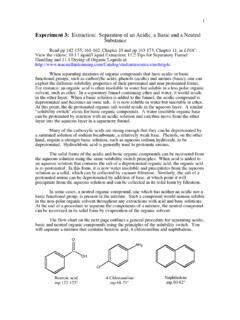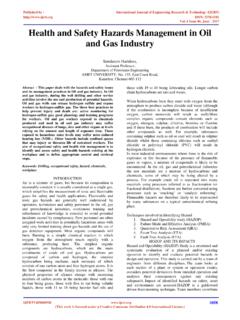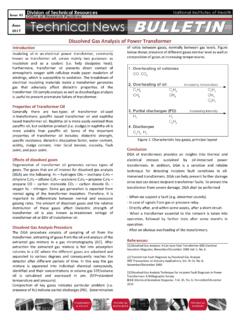Transcription of Financing options in the oil and gas industry - Milbank
1 Financing options in the oil and gas industry , Practical Law UK Practice 2018 Thomson Reuters. All rights options in the oil and gas industryby Suzanne Szczetnikowicz and John Dewar, Milbank , Tweed, Hadley & McCloy LLP and Practical Law notes | Maintained | United KingdomScope of this noteIndustry overviewUpstreamWhat is an upstream oil and gas project?Typical equity structureRelationship with the stateKey commercial contracts in an upstream projectSpecific risks in Financing an upstream projectSources of Financing in the upstream sectorMidstream, downstream and integrated projectsTypical equity structuresWhat is a midstream oil and gas project?
2 Specific risks in Financing a midstream projectWhat is a downstream oil and gas project?Specific risks in Financing a downstream projectIntegrated projectsSources of Financing in midstream, downstream and integrated projectsMulti-sourced project financeShareholder fundingEquity bridge financingAdditional sources of financingOther Financing considerations for the oil and gas sectorsExpansion financingsHedgingRefinancingCurrent market trendsA note on the structures and Financing options and risks typically associated with the oil and gas options in the oil and gas industry , Practical Law UK Practice 2018 Thomson Reuters. All rights of this noteThis note considers the structures, Financing options and risks typically associated with the oil and gas industry .
3 Itis written from the perspective of a lawyer seeking to structure a project that is capable of being financed and alsoaddresses the aspects of funding various components of the industry from exploration and extraction to refining,processing, storage and addition, this note considers the typical features of oil and gas Financing including the fact that such projects: Can be on a very large scale. Often take many years from inception to the point at which the end product is sold to consumers. Almost invariably involve government bodies. Are subject to certain specific risks over and above those more generally found in a project Financing note is intended to provide an overview for those advising on the Financing of projects in the oil or gas industries,or to those who are seeking to understand the typical structures and risks involved in oil and gas more general information on the nature of gas and/or oil projects, see Practice notes: Downstream gas industry : overview.
4 Downstream gas sector: terminology. Financing liquefied natural gas projects. Anatomy of a gas-fired power project. International joint ventures: oil & overviewThe oil and gas industry underpins many national economies through: Its supply of energy to industry and the domestic end consumer. The export and import of raw materials, and derivative manufactured and refined products. Job creation. Revenue generation. Furthering of inter-governmental connections and trade links. The generation of royalties and tax industry is typically divided into three major operational components: Financing options in the oil and gas industry , Practical Law UK Practice 2018 Thomson Reuters.
5 All rights Upstream (or exploration and production (E&P)). Midstream. overview of the various components of the industry is set out below:Providing access and exploration rights to, and consequently monetising, a country's hydrocarbons alongside thedevelopment of transportation and processing facilities for such products can be of considerable benefit to a nationaleconomy. Private sector technical expertise and equity investment potential is leveraged alongside the participationof state-owned national oil and gas companies (NOCs) to maximise the benefit obtained by the relevant state (aswell as the equity investors) and to enable the NOCs to grow their technical participants in the oil and gas industry include: International oil companies (IOCs) and other corporate entities, who have historically dominated this sectorand who are distinguished by market capitalisation into: super majors (for example, ExxonMobil, BP, Shell and Total); majors (for example, ENI and Repsol).
6 AndFinancing options in the oil and gas industry , Practical Law UK Practice 2018 Thomson Reuters. All rights mid-cap/independents (for example, Ophir, Tullow, Noble Energy and Premier Oil). NOCs (for example, Saudi Aramco, Qatar Petroleum, ADNOC, Petrobras, Gazprom, CNOOC, PETRONAS andKNOC). Global traders (for example, Glencore, Vitol and Trafigura). Private equity and hedge funds (for example, Blackstone, Carlyle and Och-Ziff). State-owned investment funds (for example, China Investment Corp and IPIC). Pension funds and insurance companies (for example, OMERS and Ontario Teachers). Services companies (for example, Nabors, Schlumberger, Halliburton and Seadrill).
7 Shipping companies for liquefied natural gas (LNG) and other hydrocarbons (for example, Golar, GasLog andMitsui). Industrial manufacturing companies and refiners (for example, The Dow Chemical Company, RelianceIndustries and Essar).In view of the capital intensive nature of oil and gas projects and the varying degrees of risk to which stakeholdersare exposed (in part, depending on the stage of a project's development and operations), equity investors typicallyrequire different sources of Financing over the life of a project. Key Financing options employed include: Equity sources. IPOs, cash calls (under a joint operating agreement (JOA) (see Key commercial contractsin an upstream project)), shareholder loans and share subscriptions.
8 Third party Financing products. Corporate loans, acquisition Financing , reserve based lending (RBL),equity bridge loans (EBLs), project finance, capital markets, hybrid financings and hedging. Other sources. Operational current or future cashflow and the raising of funds through asset feature common to many of the above in an oil and gas context is the detailed technical, legal, market, financialand regulatory due diligence carried out on what can often be complex and bespoke projects. A petrochemicalscomplex comprising multiple interconnected units, such as the Sadara petrochemical plant in Saudi Arabia, forexample, requires a comprehensive understanding of, among others, the interface risk in construction and operation,the licensing and technology arrangements and the relevant product markets and sales arrangements.
9 In addition,rigorous environmental and social standards are expected by debt and equity financiers alike to avoid the occurrenceof catastrophes of significant commercial or reputational consequence (or both).As is the case for other large-scale projects, factors framing the risk assessment for an oil and gas project and, inturn, the availability of Financing , include: The type of project and the nature of transaction. The project's location and consequential political, legal, regulatory, economic, social and environmentalconsiderations. The identity, creditworthiness, existing liabilities and contractual rights and obligations of key projectstakeholders and participants, including the sponsors, offtakers, feedstock suppliers, regulators, contractors,utility suppliers and operator (as applicable).
10 The availability and coverage of options in the oil and gas industry , Practical Law UK Practice 2018 Thomson Reuters. All rights Individual institutional requirements (for example, capital reserve allocations) and risk appetites (for example,country risk, environmental and social responsibility, source of funds and sanctions regimes).Over time, the industry has established means of addressing these risks to facilitate the structuring of "bankable"projects through the adoption of recognised frameworks with modifications required to ensure financiers are ableto obtain internal credit approvals to proceed. For further details on risk factors, see Practice note, Identifying andmanaging project finance risks: overview (UK).












